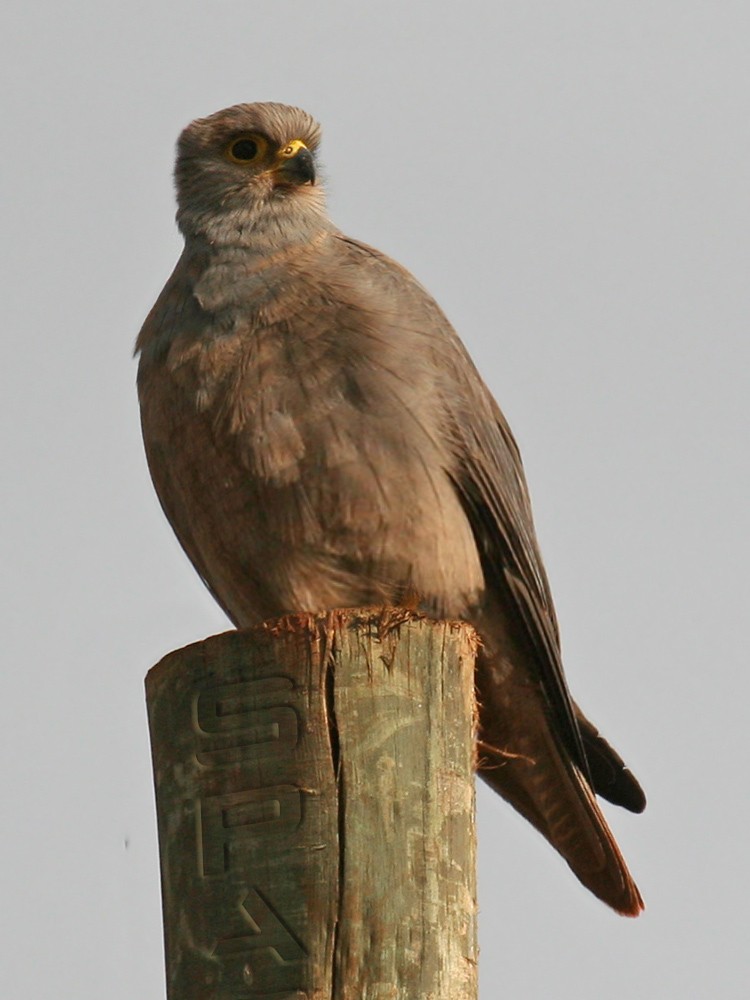Grey Kestrel
A species of True Falcons Scientific name : Falco ardosiaceus Genus : True Falcons
Grey Kestrel, A species of True Falcons
Botanical name: Falco ardosiaceus
Genus: True Falcons
Content
Description General Info
 Photo By nagualdesign , used under CC-BY-SA-3.0 /Cropped and compressed from original
Photo By nagualdesign , used under CC-BY-SA-3.0 /Cropped and compressed from original Description
It is a fairly small, stocky kestrel with a large, flat-topped head and fairly short wings that don't reach past the tip of the tail when at rest. It is 28–33 cm long with a wingspan of 58–72 cm and a weight of up to 300 grams. The female is 4-11% larger and 5-11% heavier than the male. The plumage of the adult is uniformly dark grey apart from darker wingtips, faint dark streaking on the body and slightly barred flight feathers. The feet and cere are yellow and there is bare yellow skin around the eye. The most similar species is the sooty falcon which has a more rounded head, long wings extending past the tail and less yellow around the eye. Juvenile grey kestrels are browner than the adults with a greenish cere and greenish around the eye. Juvenile Dickinson's kestrels are similar but have a barred tail and a more strongly barred underwing. The grey kestrel is generally silent outside the breeding season but has a shrill, chattering call and a rattling whistle. 
Size
33 cm
Nest Placement
Cliff
Feeding Habits
Grey Kestrel primarily feeds on insects, small reptiles, and vertebrates. They forage from high perches, striking ground prey or hawking aerial targets. Vertebrate prey dominates by weight, despite a higher quantity of invertebrates. Occasionally, grey Kestrel consumes oil palm fruits and may gather in groups for insect emergences. Hunting peaks in the late afternoon, with variations in hovering behavior.
Habitat
The grey Kestrel typically inhabits open woodlands, savannas, and forest clearings, often associating with palm tree-dominated areas near water. It is prevalent in broader geographical regions, including West and Central Africa, extending eastward to Ethiopia and parts of Kenya and Tanzania, with its southernmost reach in northern Namibia and Zambia. This species is adapted to varying elevations, seen from sea level up to 1830 meters, particularly where there are dense stands of large trees or palms adjacent to glades or burnt areas that are conducive to hunting.
Dite type
Carnivorous
General Info
Feeding Habits
Bird food type
Behavior
It is a crepuscular bird, most active at dawn and dusk. It generally hunts from a high perch but occasionally hovers. It feeds mainly on insects, lizards and small mammals such as bats but will also take birds, amphibians and worms. Prey is usually caught on the ground. It will sometimes feed on oil palm nuts, one of the few birds of prey to eat vegetable matter. Breeding occurs from March to June in the north of its range and from August to December in the south. Courting pairs perform mutual soaring displays. The eggs are usually laid in the nest of a hamerkop; most often an unoccupied nest but occasionally hamerkops will be forced out. Sometimes the kestrels will use the nest of another bird or a hole in a tree. There are two to five eggs in a clutch. They are whitish with reddish or brown markings and are incubated for 26–31 days. The young birds fledge after about 30 days. 
Species Status
Not globally threatened.
Scientific Classification
Phylum
Chordates Class
Birds Order
Diurnal Birds of Prey Family
Falcons and caracaras Genus
True Falcons Species
Grey Kestrel